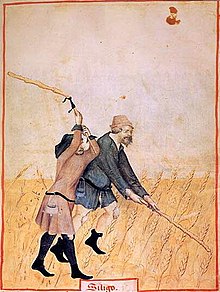Pocket: Difference between revisions
No edit summary |
|||
| Line 29: | Line 29: | ||
File:Buttoned flap box pleat pocket.png|Buttoned-flap patch pocket with box [[pleat]]. |
File:Buttoned flap box pleat pocket.png|Buttoned-flap patch pocket with box [[pleat]]. |
||
File:Smile pocket with piping.png|"Smile" slit pocket with [[piping (sewing)|piping]] and arrowhead reinforcements, typical of [[western wear]]. |
File:Smile pocket with piping.png|"Smile" slit pocket with [[piping (sewing)|piping]] and arrowhead reinforcements, typical of [[western wear]]. |
||
File:Bound pocket.png| |
File:Bound pocket.png|Welt Pocket. |
||
File:Stand pocket.pngl[pkghf[khfokh'''nhhhgg'''File:EighteenthCenturyPocketsSwaledaleMuseumReethEngland.jpg|18th century-style hanging pockets. |
File:Stand pocket.pngl[pkghf[khfokh'''nhhhgg'''File:EighteenthCenturyPocketsSwaledaleMuseumReethEngland.jpg|18th century-style hanging pockets. |
||
File:Tailored flap pocket with labels.JPG|Parts of a tailored pocket. |
File:Tailored flap pocket with labels.JPG|Parts of a tailored pocket. |
||
Revision as of 17:43, 28 January 2015

A pocket is a bag- or envelope-like receptacle either fastened to or inserted in an article of clothing to hold small items. Pockets may also be attached to luggage, backpacks, and similar items. In older usage, a pocket was a separate small bag or pouch.
Origins

In European clothing pockets began by being hung like purses from a belt, which could be concealed beneath a coat or jerkin to discourage pickpocketing and reached through a slit in the outer garment.
The word appears in Middle English as pocket, and is taken from a Norman diminutive of Old French poke, pouque, modern poche, cf. pouch. The form "poke" is now only used dialectically, or in such proverbial sayings as "a pig in a poke".
Historically, the term "pocket" referred to a pouch worn around the waist by women in the 17th to 19th centuries, mentioned in the rhyme Lucy Locket.[1] This was also called a hanging pocket.
"Pocket" is also a term for a sack in which hops were stored, generally with a capacity of 168–224 lb (76–102 kg).[citation needed]
Types
A watch pocket is a small pocket designed to hold a pocket watch, sometimes found in men's trousers and waistcoats and in traditional blue jeans.[2] However due to the decline in popularity of pocket watches, these pockets are rarely used for their intended purpose.
A besom pocket is a pocket cut into a garment instead of being sewn on. These pockets often have reinforced piping along the slit of the pocket, appearing perhaps as an extra piece of fabric or stitching. Besom pockets are found on a tuxedo jacket or trousers and may be accented with a flap or button closure.[citation needed]
Camp pockets are pockets which have been sewn to the outside of the garment. They are usually squared off and are characterized by seaming.[3][4][5]
-
Patch pocket.
-
Patch pocket with topstitching.
-
Flap pocket.
-
Buttoned-flap patch pocket with box pleat.
-
"Smile" slit pocket with piping and arrowhead reinforcements, typical of western wear.
-
Welt Pocket.
-
Parts of a tailored pocket.
-
18th-century woman's hanging pocket.
Notes
- ^ "Historic New England: Defining the Past. Shaping the Future". Spnea.org. Retrieved 2009-08-20.
- ^ "Vintage Levi's Jeans Guide - Watch Pocket". Vintage Levi's Jeans Guide. Retrieved 26 May 2012.
- ^ "What is "Camp Pockets" - Definition & Explanation". Retrieved December 1, 2011.
- ^ "camp pockets". Retrieved December 1, 2011.
- ^ "Glossary of fashion design terminology at Dress King". Retrieved December 1, 2011.
References
- Picken, Mary Brooks (1957). The Fashion Dictionary. Funk and Wagnalls.
- "Pockets". Fashion & Jewellery Features. Victoria and Albert Museum. Retrieved 2009-11-17.








